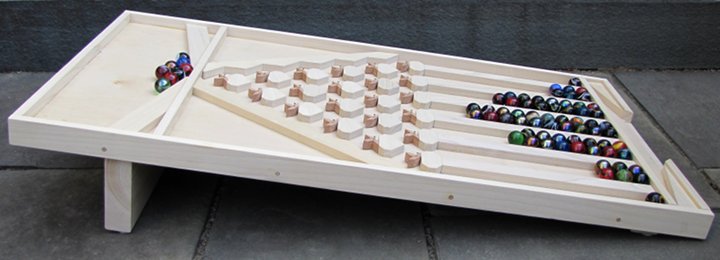

The Galton Board and the superimposed Pascal’s Triangle incorporate many mathematical, statistical and probability concepts. An even larger Eames probability machine was showcased at IBM’s Pavilion for the 1964 World’s Fair in New York. The Galton Board is reminiscent of Charles and Ray Eames’ groundbreaking 11-foot-tall “ Probability Machine,” featured at the 1961 Mathematica exhibit. It is used in the natural and social sciences to represent random variables, like the beads in the Galton Board. The bell curve, also known as the Gaussian distribution (Carl Friedrich Gauss, 1777-1855), is important in statistics and probability theory. Printed on the board are the bell curve, as well as the average and standard deviation lines. As the beads settle into the bins at the bottom of the board, they accumulate to approximate a bell-shaped curve.

When the device is level, each bead bounces off the pegs with equal probability of moving to the left or right.

When rotated on its axis, the 3,000 beads cascade through rows of symmetrically placed pegs in the desktop-sized Galton Board. The Galton Board is approved for STEM educational activities. The Fibonacci numbers (Leonardo Fibonacci, 1175-1250), can also be found as the sums of specific diagonals in the triangle. The number at each peg represents the number of different paths a bead could travel from the top peg to that peg. It also has a superimposed Pascal’s Triangle (Blaise Pascal, 1623-1662), which is a triangle of numbers that follows the rule of adding the two numbers above to get the number below. It incorporates Sir Francis Galton’s (1822-1911) illustration of the binomial distribution, which for a large number of beads approximates the normal distribution. The Galton Board demonstrates centuries-old mathematical concepts in an innovative desktop device.


 0 kommentar(er)
0 kommentar(er)
